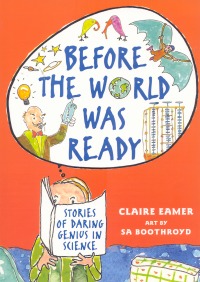| ________________
CM . . . . Volume XX Number 13 . . . . November 29, 2013
excerpt:
So begins Before the World Was Ready: Stories of Daring Genius in Science, by Claire Eamer and illustrated by Sa Boothroyd. If these two names sound familiar, it's likely you've read The World in Your Lunchbox: The Wacky History and Weird Science of Everyday Foods. Each of the eight chapters in Before the World Was Ready is focussed on a scientist that Eamer has identified as a trailbreaker: a man or a woman whose scientific ideas were so revolutionary that they were laughed at, publicly attacked, or dismissed altogether. Boothroyd's colourful, hand-drawn illustrations are interspersed through the pages of the book, and she uses her eye-catching and whimsical style to pictorially present specific events described in each biographical narrative. Readers first learn about Nicolas Copernicus (1472-1543) in a chapter titled "What have you done to my planet?" Copernicus, known to be a quiet man, is responsible for initiating what is commonly referred to as the Copernican Revolution, a scientific revolution that replaced superstition and fear with reason and knowledge. In his book De Revolutionibus Orbium Coerlstium (Concerning the Revolutions of the Heavenly Spheres), published on the day of his death, Copernicus overturned the Earth-centred universe and replaced it with am heliocentric or Sun-centred model. Humans were no longer thought to "lay at the centre of creation." Eamer, however, informs readers that Copernicus was not the first to suggest this model. It had been proposed in 260 BCE by the Greek astronomer Aristarchus and in 499 CE by Aryabhata, a 23-year-old astronomer in India. She also describes the telescopic observations of Galileo that supported Copernicus' writing almost a century after his death and also led to Galileo's living out his life under house arrest for promoting the heliocentric model. The final page of this 14 page chapter is used to describe the work of Caroline Herschel, the sister of astronomer William Herschel, and how she came to be know as "the most famous woman astronomer of her day." In a similar fashion, Eamer presents the stories of Alfred Wegener, a meteorologist known for having "set the world beneath our feet in motion" with his idea of continental drift; Ignaq Philipp Semmelweis who discovered the relationship between physicians' contaminated clothing and hands and puerperal fever (childbed fever) that killed mothers and their babies at birth; Charles Darwin and his theory of evolution by natural selection; Sir George Cayley and his principles of heavier than air flight; Nikola Tesla and alternating electrical current; Charles Babbage's adding machine; and Rachel Carson's discovery of the persistence and environmental damage associated with the use of the insect killing chemicals like DDT (dichloro-diphenyl-tricholroethane). From the stories of these trailblazers, readers will come to realize that, like Copernicus, Wegener, Semmelweis, Cayley, and Babbage died before their ideas were supported by new evidence and accepted by the scientific community and society. Darwin and Carson lived long enough to see the beginning of change, but in both cases, as Eamer states in the Carson narrative, "the battle isn't over." Tesla is unique in this regard, but, according to Eamer, "in many ways he lost the war." Tesla's ideas about alternating current were eventually used by Westinghouse, and he became a "star" with money, admiration, and honors." Tesla also continued to invent and file patents, even thought the majority of his inventions were revolutionary and their use beyond the most people's comprehension. He eventually had no investors and died in debt in a hotel room that had become his home. Implicit in Eamer's writing are interesting pieces of information that help to illuminate the nature of science and how difficult it is for new ideas to replace old ways of thinking and understanding the natural world. Often it is members of the specific discipline of science in question that are the most resistant to change, and this resistance can be a consequence of many factors including professional status and gender. However, the "war" between Tesla and Thomas Edison was more financial and what was to be gained monetarily than the physics of electricity. Since the content of many of the chapters aligns with clusters in Canadian science curricula at the middle years level, I envision many cognitively engaging discussions in classrooms that focus on the details Eamer has incorporated in each fascinating story of a "daring genius in science." Highly Recommended. Barbara McMillan is a teacher educator and a professor of science education in the Faculty of Education, the University of Manitoba, Winnipeg, MB.
To comment
on this title or this review, send mail to cm@umanitoba.ca.
Copyright © the Manitoba Library Association. Reproduction for personal
use is permitted only if this copyright notice is maintained. Any
other reproduction is prohibited without permission.
NEXT REVIEW |
TABLE OF CONTENTS FOR THIS ISSUE
- November 29, 2013.
AUTHORS |
TITLES |
MEDIA REVIEWS |
PROFILES |
BACK ISSUES |
SEARCH |
CMARCHIVE |
HOME |
